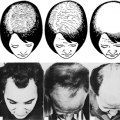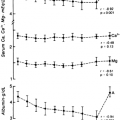CLINICAL PRESENTATION
Part of “CHAPTER 58 – PRIMARY HYPERPARATHYROIDISM“
Patients with primary hyperparathyroidism may present with one of several clinical pictures: asymptomatic hypercalcemia; bone or stone disease; other recognized complications, such as neuromuscular, gastrointestinal, articular, hematologic, or central nervous system features; “normocalcemic” hyperparathyroidism; acute primary hyperparathyroidism; parathyroid carcinoma; MEN1 or MEN2A; FIPH; familial cystic parathyroid adenomatosis; or neonatal hyperparathyroidism.46 The most common form is mild hypercalcemia without any specific signs or symptoms.
The increased incidence of primary hyperparathyroidism reflects recognition of a population brought to the physician’s attention by the incidental determination of calcium levels. Usually, these asymptomatic patients have serum calcium levels that are not more than 1 mg/dL above the upper limits of normal.47 Other test results, such as those for serum phosphorus and the alkaline phosphatase, are usually normal. In marked contrast to this presentation is an unusual and life-threatening form, acute primary hyperparathyroidism. Patients with this disorder are symptomatic and present with extremely high serum calcium values (>15 mg/dL).48 Approximately 25% of patients reported with this form of primary hyperparathyroidism have a previous history of mild hypercalcemia. Patients with acute primary hyperparathyroidism have extremely high serum PTH levels. In one review, the serum calcium value for 43 patients was 17.5 ± 2.1 mg/dL (mean ± standard deviation). In marked contrast to patients with asymptomatic primary hyperparathyroidism, virtually all patients were symptomatic. Unlike primary hyperparathyroidism, acute primary hyperparathyroidism involved both bone and kidney in one-half of the patients. More than two-thirds of patients had nephrolithiasis or nephrocalcinosis. The clinician must recognize that life-threatening hypercalcemia may be the result of acute primary hyperparathyroidism, because this is a curable disease.
Stay updated, free articles. Join our Telegram channel

Full access? Get Clinical Tree





